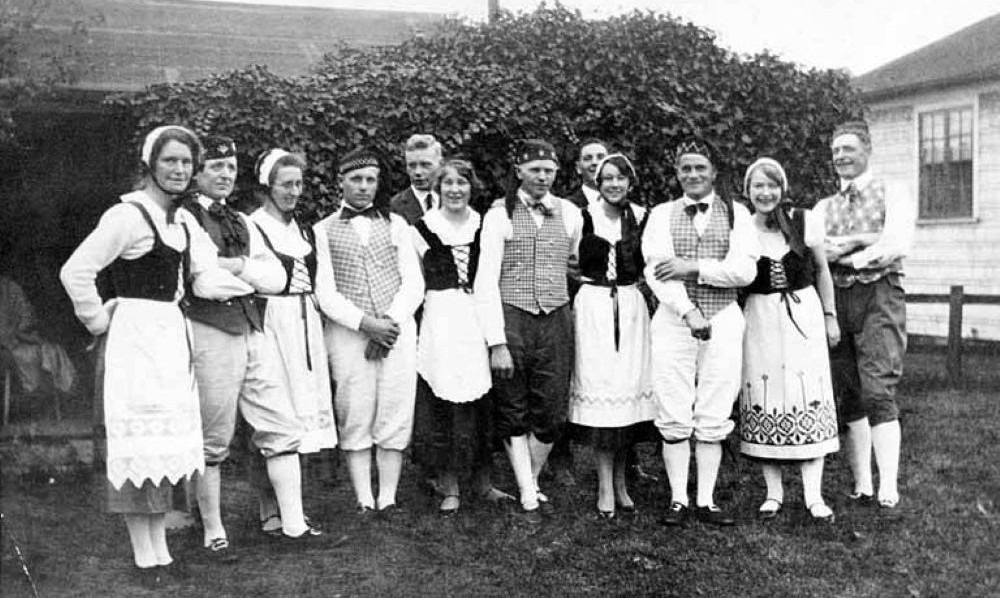Seattle’s Ballard neighborhood, once an independent port town, is known for its Scandinavian roots. Those roots have been exposed, nurtured, and celebrated through displays and programs at the Nordic Heritage Museum and other sites. Here’s a closer look at another group, our Nordic neighbors.
Nordics — that is, immigrants and their progeny from Iceland, Finland, Sweden, Denmark, and Norway — left their mother countries during the 1830s to 1880s because of severe economic problems. A scarcity of land among the fjords and mountains, coupled with population growth, caused a squeeze on existing Old Country resources. Because industrialization came relatively late to Scandinavia and Northern Europe, urban centers could not absorb the influx of desperate farmers, fishers, and others. These factors combined to drive Nordics to the North American continent. Many of those struggling individuals earlier roamed Europe looking for land and work.
The Atlantic crossing to North America was usually by steerage, in crowded conditions aboard sailing ships and, later, steamers. Norwegians usually departed from Bergen, whereas Finns and Swedes often transshipped to Liverpool. Danes frequently travelled the North German Lines. Icelanders generally kept a due west course to Canada, then migrated across the Canada-U.S. border to the Midwest.
Like most other Europeans, the bulk of Nordic immigrants arrived at New York’s Castle Gardens and Ellis Island. With little money and less knowledge of the English language, many were easy prey for dishonest agents who made empty promises of help and jobs. Except for the few who managed to reach rural communities out west, Nordics found the teeming slums of New York City and Chicago their first American homes.
In time, the great western lands and waters attracted Nordics to familiar professions: dairying, logging, fishing, mining, and village businesses. During the late 1880s Scandinavians found their way to the Pacific Northwest, despite its moist climate west of the Cascade Mountains. In 1910 it was estimated that one quarter of Washington State’s residents were of Nordic origin.
The logging and wood industry attracted Finns, Norwegians, and Swedes. Columbia River gillnet fishing was often dominated by Finns. Salmon trolling in Pacific Northwest waters was attractive to Swedes and Finns. Halibut fishing was at one time the almost exclusive domain of Norwegians, while Icelanders tended to work the cod fishery. Later, several important crab fishing businesses were Norwegian owned.
Nordics also became active and successful boat builders, several of them locating on Shilshole Bay in Seattle’s Ballard. Finns and Norwegians helped develop the Coeur D’Alene and Klondike mines, and others gravitated to stump farms in Pierce and King counties and in S.E. Washington.
Many local Nordics have cited Seattle’s Ballard as their distinctive root neighborhood in the Pacific Northwest.
Discover more from Post Alley
Subscribe to get the latest posts sent to your email.

My grandfather, Peder Ongstad, was one of those Norwegians who ended up in the PNW, and even Alaska. He was part of the Norwegian contributors to the AYP.
Query: Are there any Scandinavian restaurants left in Ballard, aside from Nordic Museum?
Scandinavian Specialties on 15th Northwest features terrific smorrebrod at their cafe, along with a well-stocked Nordic deli for takeout. Skyr on Ballard Avenue is terrific, especially if you go for the unapologetic Viking approach.
Also, if you’re fortunate enough to have a Norski friend who can slip you into the Sons of Norway Lodge when they’re serving lunch you can score big and cheap.
https://www.byenbakeri.com/ This is a Seattle favorite, not a restaurant but a bakery
Scandinavian immigrants from Tacoma were founders of Petersburg, AK, not one of Alaska’s easily accessible ports, but definitely Norsk in character. At least one Seattle family of my ken sent their daughter to Seattle for high school, and then college, getting her away from the, ah “sporting nature,” of that fising community. Seattle’s early TV days cheerfully poked insulting ethnic fun at Scandinavian immigrant culture – e.g.the top-rated children’s program, KING’s Clubhouse, with Stan Boreson – featuring the character of “Uncle Torvald” who sported weird hair and simplistic persona. Stan’s vocal creations and accordion music are remembered by 1950s Seattleites: “Walkin’ in my Winter Underwear” and “Lena Got Run Over by a Reindeer.” Like so many savvy Nordics, when KING “moved on,” he shifted into real estate and other sophisticated fiscal ventures.